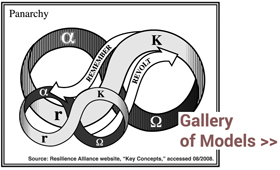The term resilience has specific meanings in engineering, psychology, and ecology. What might it mean for people-in-place to be resilient? A region, say, as my Ecotrust colleagues and I examined a few years ago, or a city or a neighborhood.
These days, there is a lot of discussion about resilient cities, and last month, the excellent Nature of Cities blog hosted a roundtable on the question: “How do you measure resilience in cities?”
Twenty-one respondents from around the world weighed in with their thoughts and experiences.
Participatory practices caught my eye. Richard Friend and Pakamas Thinphanga in Bangkok described their use of shared learning dialogue and of a UNISDR Local Government Self-Assessment Tool. William Dunbar in Tokyo described community-based use of an International Partnership for the Satoyama Initiative (and partners) indicators toolkit.
With regard to measurement, there was a fair amount of skepticism as well, notably from ecologist Lance Gunderson, co-editor of the book Panarchy: Understanding Transformations in Human and Natural Systems.
When faced with a new type of collective problem, we try to gather information in order to develop an understanding that helps direct how we act or intervene. In this case, trying to understand and direct trajectories of cities or urban centers over time, the concept of resilience has become part of the discourse. In efforts such as the Rockefeller Foundation’s 100 Resilient Cities, or NOAA’s Coastal Resilience program, resilience is the central organizing theme. Implicit in these programs is the use of resilience as a normative term (as in a city or coast should be resilient). Yet there are a number of resilient facets of cities, such as slums, impoverished economic zones, or air-pollution zones that are very resilient. Such areas can be quite resilient, yet are not desirable.
Attempting to measure or index resilience (and there are lots of folks that say they can measure resilience) creates a spurious certitude that is likely to drive maladaptive actions and constrain creative and productive actions that may help change unwanted trajectories.

